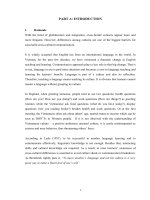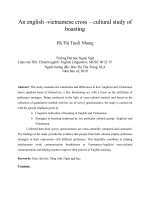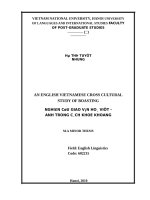an english - vietnamese cross - cultural study of idioms with colors and its implications to elt = nghiên cứu giao văn hóa anh - việt về các thành ngữ chứa từ chỉ màu sắc và áp dụng trong việc giảng dạy tiếng anh
Bạn đang xem bản rút gọn của tài liệu. Xem và tải ngay bản đầy đủ của tài liệu tại đây (1.18 MB, 47 trang )
Vietnam national university Hanoi
College of foreign languages
Department of post-study
ĐẶNG THỦY TRINH
AN ENGLISH-VIETNAMESE CROSS-CULTURAL
STUDY OF IDIOMS WITH COLORS
AND ITS IMPLICATIONS TO ELT
Nghiên cứu giao văn hóa Anh-Việt về các thành ngữ chứa từ chỉ màu sắc
và áp dụng trong việc giảng dạy tiếng Anh
Minor Thesis
Code
60 22 15
hµ néi - 2009
Vietnam national university Hanoi
College of foreign languages
Department of post study
ĐẶNG THỦY TRINH
AN ENGLISH-VIETNAMESE CROSS-CULTURAL
STUDY OF IDIOMS WITH COLORS
AND ITS IMPLICATIONS TO ELT
Nghiên cứu giao văn hóa Anh-Việt về các thành ngữ chứa từ chỉ màu sắc
và áp dụng trong việc giảng dạy tiếng Anh
Minor Thesis
Code
60 22 15
Supervisor: Assoc. Prof. Ph.D Nguyễn Xuân Thơm
hµ néi - 2009
iv
TABLE OF CONTENTS
ACKNOWLEDGEMENT. i
ABSTRACT ii
A. INTRODUCTION 1
1. Rationale for the study 1
2. Scope of the study 2
3. Objectives of the study 2
4. Methodology of the study. 3
B. DEVELOPMENT . 4
Chapter 1: Literature Review 4
1. Definition of idiom 4
2. Cultural characteristics of English idioms 5
3. Classification of idiom . 6
4. Use of idiom. 9
5. Definition of color 10
6. Classification of colors 10
7. Denotational and connotational meaning of colors 11
8. The difference in colors’ meaning and symbolism 14
Chapter 2: English Vietnamese cross-cultural understanding and use of idioms
with colors and findings 16
1. Description of the survey 16
1.1. Reasons for chosen methods to survey. 16
1.2. Informants 17
1.3 Data collection methods 18
2. Data analysis and findings 19
2.1 Data collection . 19
v
2.2 Findings 20
2.3 Mistakes 21
2.4 Causes 22
Chapter 3: Implications 23
1. Suggestions for teaching and learning idioms with color 23
2. Some suggested exercises for better study of idioms with color 28
3. Recommendations for further studies 32
C. CONCLUSIONS . 34
D. REFERENCES 36
APPENDIX
1
INTRODUCTION
1. Rationale for the study:
Up to now, English is one of the most widely used languages in the world. In
Vietnam, the number of schools and universities teaching English as a target and
compulsory subject has increased with every passing year. Moreover, due to the need for
integrating into the world, especially since the open door policy, more and more people
learn English. However, the differences between English and Vietnamese cause various
problems for Vietnamese learners of English in the process of mastering English. Many of
these problems are caused by English idioms. Idioms are embodiment of culture. They are
language essence and the most difficult part to handle with, which involve a country‘s
history, geography, local conditions, customs and cultural background. Thus you cannot
understand idioms correctly without the held of the cultural context, which in turn requires
that learners have the knowledge of the culture. Both English and Vietnamese are
expressive languages, which are very rich in idiomatic expressions. Therefore, it is greatly
necessary to make use of the cultural knowledge while learning English idioms.
Obviously, English idioms is a flexible and difficult aspect that even native
speakers cannot master well. Thus, it is necessary to take this into consideration. I myself
think that it is very interesting to research all types of idioms but because of the limitation
of graduation paper, I only focus on “An English-Vietnamese Cross-Cultural Study of
Idioms With Colors and Its Implications to ELT”, which impresses me most because
cultural approach can help achieve more accurate and lively study and learning. This urges
me much to try to do this research that may be helpful to some Vietnamese learners who
wish to use them exactly.
In summary, it is the importance of English language and correct use of English
idioms in successful communication, and the difficulties in using idioms with colors by
which my research is motivated. Moreover, the wish to help Vietnamese students be aware
of the necessity in using idioms with colors in mastering English and to improve their
language four skills has been constantly encouraging my choice of this study.
2. Scope of the study
2
My study concentrates on “An English-Vietnamese Cross-Cultural Study of
Idioms With Colors and Its Implications to ELT” with Vietnamese learners of English
and a small comparison between Vietnamese learners and English native speakers. In this
study, colors and idioms with colors shall be investigated through cross-cultural aspect.
However, Vietnamese people learning English are various in age, purpose, occupations,
etc. Therefore, the study is mainly concerned with the Vietnamese first year students at
CFL-VNU and some English native speakers.
3. Objectives of the study:
In communication, the most important goals for foreign language learners are
understanding and expressing one‘s points of view. To reach these goals, learners not only
need to master vocabulary, grammar but also the sound patterns of idioms. A good
knowledge of idioms that can help them fulfill this.
Having witnessed and personally faced difficulties in using English idioms with
colors, my study, therefore, is aimed to raise some useful suggestions to learners of English
in avoiding communication breakdown. The purposes of the study are hereunder:
1. To provide the theoretical review of English idioms and a specification is given
to English idioms with colors.
2. To show how well Vietnamese students are exposed to English idioms in general
and English idioms with colors in particular, and how they practice, use them in mastering
English. Also, it points out wrong interpretations that are usually encountered and made by
students when using English idioms with colors, at the same time, seeks the sources of
such mistakes.
3. To supply some suggested implications for teaching and learning method, and
some activities and exercises that can be useful for practicing English idioms with colors in
teaching and learning process, contributing to improve ability of using English idioms with
colors.
4. Methodology of the study:
3
During the completion of the study, both the quantitative and qualitative methods
were employed in order to gather reliable and sufficient information and data. Quantitative
data are numeric information that is subject to statistical analysis, and qualitative data are
text-based information that provides descriptive details, collected from interviews and
observations.
Specifically, the major methods are studying on reference materials and collecting
useful knowledge and theories. Besides, conducting survey questionnaires and in-depth
interviews along with observation are some other methods of the study.
DEVELOPMENT
CHAPTER 1: LITERATURE REVIEW
4
1. Definition of English idioms
Idioms are a class of multi-word units ―which pose a challenge to our
understanding of grammar and lexis that has not yet been fully met‖ (Fellbaum et al.,
2006:349). They are commonly believed to be qualitatively different from ―normal‖
language, but the precise nature of this difference can be elusive. Even amongst idiom
scholars, it is difficult to find a consensus as to what precisely is, or is not, an idiom,
because of the heterogeneity of the class.
There is widespread agreement on one general principle: an idiom is an
institutionalized expression whose overall meaning does not correspond to the combined
meanings of its component parts. However, this criterion can be said to apply to a wide
range of phrase-ological structures, such as collocations, formulaic greetings, clichés, and
other conventionalized expressions which, although idiomatic to some extent, are not
idioms in the strict sense. The challenge for idiom researchers is therefore to formulate a
definition which is flexible enough to conclude all known idioms, yet exclude non-idioms
such as those mentioned above.
Current psycholinguistic views support the argument in favour of considering
idiom as a type of ―long word‖ whose meaning is accessed directly, and not through prior
decomposition or analysis of the constituents (Gibbs 1994, 2002). On the other hand, when
an idiom is encountered for the very first time, language users have no choice but to
decipher its meaning from the meaning of constituents, they usually do so by taking into
account the most salient, or prominent, meanings first (Giora 1997, 2002; Peleg & Giora
2001). That this tactic enjoys a limited success rate is due to the difficulty in identifying
which meaning of polysemous components is relevant, and the extent to which the idiom is
semantically motivated, or transparent.
If you look up the word idiom in Webster, you will be given the following definition:
Idiom is an expression whose meaning is not predictable from the usual meanings
of its constituent element as kick the bucket, hang one's head etc., or from the general
grammatical rules of language, as the table round for the round table, and which is not a
constituent of a larger expression of like characteristics.
5
This definition seems a bit dry and doesn't really tell anything about the function of
idioms in English language.
English is a language particularly rich in idioms — those modes of expression
peculiar to a language (or dialect) which frequently defy logical and grammatical rules.
Without idioms English would lose much of its variety and humor both in speech and
writing.
2. Cultural characteristics of English idioms:
The abundance and variety of English idioms may be to a great extent accounted
for the historical development of the language. Many idiomatic expressions come from the
everyday life of the English people from all walks of life. The Bible is also one of the chief
source from which idiomatic expressions have sprung. After the Bible, Shakespeare's plays
are the rich literary sources of English idioms. Many idioms also come from fables, myths
or legends.
Besides, English idioms are created by people in different trades and occupations.
A large proportion of idioms are first created by working people such as seamen on the
sea, hunters in the woods, farmers in the fields, workmen at mills, housewives and cooks in
the kitchen and so on, using familiar terms that are associated with their own trades and
occupations. For example, ―in deep water‖, ―tide over‖ were first used by seamen; ―kill
two birds with one stone‖ used by hunters; ―have all one's eggs in one basket‖ used by
farmers; ―new brooms sweep clean‖ used by housewives; ―boil down‖ used by cooks, etc.
Such expressions prove terse, vivid, forcible and stimulating so that later they broke out of
their bounds and gradually gained wide acceptance. As a result, they became part of the
common of core of the language culture and are now used in different situations.
Because the cultural backgrounds between English and Vietnamese languages are
different, so there are some visible differences between the two. As a part of language,
idioms reflect the rich and colorful features of a nation. Therefore, there are some cultural
differences between English and Vietnamese idioms. They are as follows:
2.1 Living environment differences
6
Idioms have tight relationships with people's work and lives. England is an island,
so it cherishes water very much. Then in English, it has such idiom as ―spend money like
water‖.
2.2 Conventional differences
The typical conventional difference should be people's attitude towards the animal
dog. In most Western counties, dog is associated with ―loyalty, faithfulness‖, it is a ―close
companion‖ to people, whereas in Vietnamese, the word dog usually has a negative
meaning. So in English, ―You are a lucky dog‖, the word dog here has no contemptuous
meaning.
2.3 Differences in religious belief
Religious belief has a great impact on the English idioms. They bring many new
ideas and customs that are related to religious belief. For example, ―God helps those who
help themselves‖; ―Go to hell‖.
2.4 Historical differences
Quite a few English idioms are born just due to particular historical events. ―To
cross the Rubicon‖, ―to meet one's Waterloo‖ come from Napoleon and the breakdown of
his empire; and the American Civil War is the source of ―by the grapevine‖ and so on.
3. Classification of idiom
Classification can be approached from different criterion. There are a variety of
criteria for classifying English idioms. This paper prefers the criterion of cultural style. By
this criterion, English idioms may be classified into five groups: colloquialisms, proverbs,
slang, allusions and phrasal verbs. Such classification will be more helpful in the actual
studying, learning, use and translation of idioms. Generally speaking, English idioms have
different styles, most of which are used in any situation, some in formal style or in slang.
The knowledge of this classification of English idioms will undoubtedly be beneficial to
learners and translators.
3.1. Colloquialisms









